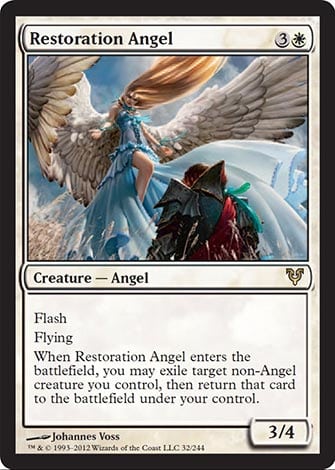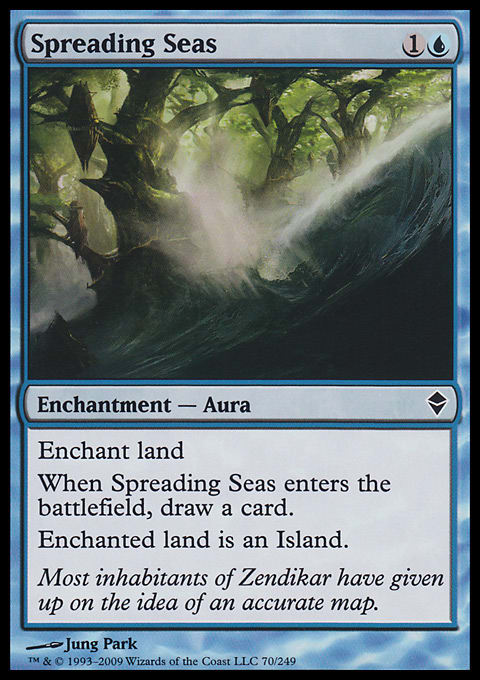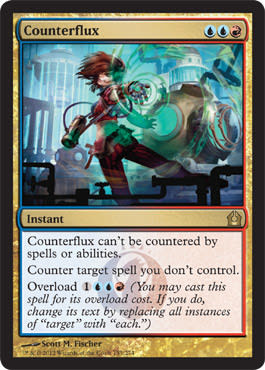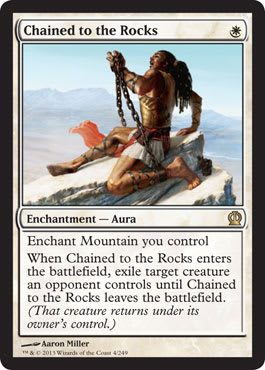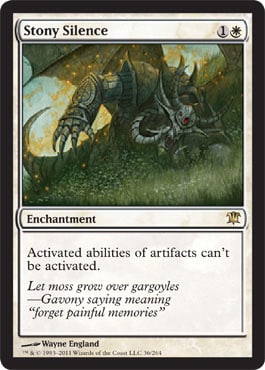Since I live in Michigan, there’s no reason not to attend the Grand Prix in Detroit since it’s in my own backyard. I also don’t mind the Modern format since I am able to play with most of my favorite cards from recent years. Of course, I have to leave my old pals like Jace, the Mind Sculptor, Bitterblossom, and Ancestral Vision on the sidelines, but I’ll manage.
For those of you familiar with my play style, it won’t come as a shock that I have been championing R/W/U control for many months. The deck was also putting up results in big tournaments as well as Magic Online Daily Events, so I felt it was a good choice.
Everything seemed to be going my way except for one thing: I didn’t like the way the hive mind made the deck.
Here’s an example of what the traditional version looked like before Grand Prix Detroit in a Daily Event:
"Modern R/W/U Control"
- Creatures (3)
- 3 Snapcaster Mage
- Planeswalkers (2)
- 1 Ajani Vengeant
- 1 Gideon Jura
- Spells (29)
- 1 Shadow of Doubt
- 2 Lightning Helix
- 2 Path to Exile
- 2 Sphinx's Revelation
- 2 Think Twice
- 3 Lightning Bolt
- 3 Mana Leak
- 3 Spell Snare
- 4 Cryptic Command
- 4 Electrolyze
- 1 Wrath of God
- 2 Supreme Verdict
- Lands (26)
- 1 Mountain
- 1 Plains
- 3 Island
- 1 Glacial Fortress
- 1 Sacred Foundry
- 1 Steam Vents
- 2 Hallowed Fountain
- 3 Arid Mesa
- 3 Scalding Tarn
- 3 Sulfur Falls
- 3 Tectonic Edge
- 4 Celestial Colonnade
- Sideboard (15)
- 2 Celestial Purge
- 2 Counterflux
- 2 Grafdigger's Cage
- 2 Relic of Progenitus
- 1 Shadow of Doubt
- 2 Sowing Salt
- 1 Spellskite
- 2 Stony Silence
- 1 Wear // Tear
I wasn’t a fan of playing the clunky planeswalkers in the main deck because there are plenty of Modern decks that can kill you the second you tap out. Ajani Vengeant and Gideon Jura aren’t powerful enough to justify that risk; I want to play more instants. The sorcery-speed bombs also conflict with casting Cryptic Command, which leads to awkward choices in the tournament. How do you know if it’s worth tapping out on turn four?
Wrath of God is a removal spell that is good against creature decks but horrendous against the rest of the field. If I have a dead card in the main deck, it would be nice if it contributed to a coherent strategy. For this reason, I championed removal in the form of burn (and a few copies of Path to Exile).
The small number of creatures also makes it difficult to apply pressure when you’re behind. It makes unfavorable matchups worse because it’s difficult to capitalize on weak draws when your opponent has twenty turns to win. Taking unintentional draws can also make or break a Grand Prix because Day 2 requires a record of 7–2 or better. If you draw on Day 1, it’s almost as bad as a loss.
With all of these things in mind, let’s take a look at how I approached the archetype:
"Modern R/W/U Control Updated"
- Creatures (8)
- 2 Restoration Angel
- 3 Snapcaster Mage
- 3 Vendilion Clique
- Spells (26)
- 2 Lightning Helix
- 2 Spell Snare
- 2 Sphinx's Revelation
- 3 Mana Leak
- 3 Path to Exile
- 4 Cryptic Command
- 4 Electrolyze
- 4 Lightning Bolt
- 2 Spreading Seas
- Lands (26)
- 1 Mountain
- 1 Plains
- 2 Island
- 1 Mystic Gate
- 1 Sacred Foundry
- 2 Hallowed Fountain
- 2 Steam Vents
- 2 Sulfur Falls
- 3 Arid Mesa
- 3 Tectonic Edge
- 4 Celestial Colonnade
- 4 Scalding Tarn
- Sideboard (15)
- 1 Sowing Salt
- 1 Teferi, Mage of Zhalfir
- 1 Wear//Tear
- 1 Lightning Helix
- 1 Spell Snare
- 1 Dispel
- 1 Wrath of God
- 1 Hallowed Burial
- 2 Stony Silence
- 1 Batterskull
- 2 Counterflux
- 1 Grafdigger's Cage
- 1 Celestial Purge
At first glance, these two decks are the same, but the differences have altered the way the game is played. A quick Vendilion Clique against a combo opponent will ensure you have a way to end the game before it’s too late.
Restoration Angel has replaced the planeswalkers so I have the option to cast a creature at the end step or use a Cryptic Command if necessary. It’s also powerful against combo with a Vendilion Clique in play since I can use the ability a second time. There will also be times when I am able to blink out Snapcaster Mage to recast a cheap instant. It’s also important that Restoration Angel has 4 toughness and costs 4 mana in a world of Lightning Bolt, Lightning Helix, and Abrupt Decay.
The days leading up to the Grand Prix had folks speculating on the popular decks; everyone said Affinity and Tron would show up in droves. Vendilion Clique can strip Tron of the few threats in the deck and also provide the necessary clock to end the game before Emrakul, the Aeons Torn comes into play. Tron has the inevitability in the late game.
The other piece of technology in this deck was also inspired by the popularity of Tron: Spreading Seas. This pesky little cantrip can shut off the Urzatron before Karn Liberated comes into play, but it also shuts off Eye of Ugin. It was easy to make room for this card; all I had to do is cut the Think Twices. I don’t want a cantrip that doesn’t affect the board because Modern decks can kill you very quickly.
During the Grand Prix, I faced zero Tron opponents, but Spreading Seas was still an all-star for me. Here are some awesome things it did in eight rounds:
- Shut off Tectonic Edge
- Shut off Celestial Colonnade
- Color-screw my tri-colored opponent
- Turn Temple Garden into an Island, which made Isolated Chapel come into play tapped
- Turn Overgrown Tomb into an Island, which allowed for Isolated Chapel to come into play tapped (in a different round)
- Color-screw a mill opponent (cut off black)
This card even has applications against Affinity and Jund (killing man lands), which makes this a great call for the metagame. It was the most impressive card in my deck, and my only regret is not playing another copy. My opponents were also impressed by how much impact a single cantrip had on the game; give it a try!
I began the Grand Prix with a 4–1 record, but I lost the sixth round to land-screw two games in a row against Sam Pardee with Melira Pod. The following round had the same awkward draws of Tectonic Edges with a fist full of Cryptic Commands and Sphinx's Revelations.
Here are some things I learned about my deck from the tournament:
- I had too many expensive spells. It would seem that cutting big planeswalkers would have made my mirror match horrible, but I beat R/W/U twice in the event. There was little trouble closing a game, so I could cut down on the bombs.
- Having two Spell Snares was just right. Despite it being amazing against some of the more popular decks, the tier-two and tier-three decks cared about it less. There are enough decks in the format that kill without a 2-drop that I don’t care to flood out on blanks.
- Dispel and Counterflux are awesome. If you thought playing Cancel for


 wasn’t good in Modern, think again.
wasn’t good in Modern, think again. - Having three Tectonic Edge made for some very awkward draws. I would cut it down to two and make room for more Spreading Seas to make up for having fewer answers to lands. It’s reasonable to have the third Tectonic Edge in the sideboard for the mirror and Tron.
- Teferi, Mage of Zhalfir was too cute. I boarded it in in multiple rounds, and its only use was to make my land-light draws worse. Since I already had four Cryptic Command, there were too many spells that cost


 . My deck had a ton of countermagic post-board in the matchups where I wanted Teferi, but I couldn’t protect it.
. My deck had a ton of countermagic post-board in the matchups where I wanted Teferi, but I couldn’t protect it. - Grafdigger's Cage wasn’t very impressive. The primary function was to shut off Birthing Pod, but Stony Silence is more robust. It made me want to board out a Snapcaster Mage despite it being able to bring back cheap removal against Pod. The critical mass of Stony Silence is good because Tron kills them with Nature's Claim. I use that as a way to protect my Spreading Seas from being blown up by Oblivion Stone (as well as shut off the mana artifacts).
- There has to be a better card than Sowing Salt. I only wanted this card against Tron, so I can cut it for the extra Tectonic Edge. Tron can Ghost Quarter its own Tron piece in response (fizzling it), which makes it a glorified Molten Rain. That’s still a good effect, but I want this slot to also be more robust. Paying 4 mana at sorcery speed in the mirror didn’t seem worth it, so I didn’t ever board in the Sowing Salt.
- Wrath of God is better than Supreme Verdict. Not only does Mountain and Tectonic Edge make it more difficult to cast Supreme Verdict, regeneration is a real thing in Modern. Given the dominance of B/G Rock and Jund, I want an effective way to kill Thun, the Last Troll. There are also some Affinity decks that play Welding Jar.
- I have no game against Hexproof. That was the first deck I lost to, and I have rarely felt that helpless against a real deck. Wrath of God is pretty weak against the Umbras, which called for the Hallowed Burial in the sideboard. I can play either Spellskite or Engineered Explosives to improve my matchup.
- Since the new changes to the rules regarding sideboarding, I can board up to sixty-one cards in grindy matchups such as Jund. Unfortunately, the rules don’t go the other way, so I am sticking with a sixty-card deck. Your sideboard can’t ever exceed fifteen cards.
- Theros has some cards that can address some of the problems I experienced with the deck.
I don’t want to go over my revised list until I mention the new cards from Theros because it’s going to be out very soon. Here are some possibilities:
Chained to the Rocks – This card probably won’t make the cut because Path to Exile is critical against Splinter Twin and it performs a very similar function. It’s also awkward if your enchanted Mountain dies to a Tectonic Edge, Fulminator Mage, Avalanche Riders, or Ghost Quarter or if it becomes the target of Spreading Seas.
Elspeth, Sun's Champion – Paying 6 mana is too much for a sorcery-speed win condition. You’re better off playing Gideon or Batterskull in that space.
Gainsay – This is a unique effect for Modern. Although we already have access to Negate, the ability to counter a Deceiver Exarch or Snapcaster Mage is worth considering; I’ll leave it out for now.
Swan Song – I wanted a second copy of Dispel, but a single Swan Song could also be very good. I would board in this card against Scapeshift decks, the mirror, Hexproof, and Splinter Twin. Since the drawback of giving the opponent a creature could backfire, I don’t want to play more than one copy; flooding on this spell would be awkward. It’s worth noting that you can just Electrolyze the Bird token.
Anger of the Gods – This card has the same fault as Wrath of God: It doesn’t go to the face. I could still play a copy in the sideboard because it’s cheaper than Hallowed Burial and lets Restoration Angel survive. I was considering playing a Pillar of Flame or Magma Spray because I wanted another cheap kill spell to flash back with Snapcaster Mage, and this could be the right one. When I’m playing against Birthing Pod, I want a sweeper that kills Kitchen Finks, Murderous Redcap, and Voice of Resurgence.
Steam Augury – Here’s a card I want to play in the main deck. There aren’t too many cards in each set that affect Modern due to the large card pool, but I think this card is going to be good. Sphinx's Revelation is expensive, and I rarely cast it for more than 3. There were plenty of situations in which I was afraid to tap out for Revelation because of an opposing Mana Leak in the mirror, and Steam Augury would have been better.
After Theros is out, I would try this list:
"Modern R/W/U Control with Theros"
- Creatures (8)
- 2 Restoration Angel
- 3 Snapcaster Mage
- 3 Vendilion Clique
- Spells (26)
- 2 Lightning Helix
- 2 Path to Exile
- 2 Spell Snare
- 2 Steam Augury
- 3 Mana Leak
- 4 Cryptic Command
- 4 Electrolyze
- 4 Lightning Bolt
- 3 Spreading Seas
- Lands (26)
- 1 Mountain
- 1 Plains
- 2 Island
- 1 Glacial Fortress
- 1 Mystic Gate
- 1 Sacred Foundry
- 2 Hallowed Fountain
- 2 Steam Vents
- 2 Sulfur Falls
- 2 Tectonic Edge
- 3 Arid Mesa
- 4 Celestial Colonnade
- 4 Scalding Tarn
- Sideboard (15)
- 1 Lightning Helix
- 1 Wrath of God
- 1 Anger of the Gods
- 1 Dispel
- 2 Counterflux
- 1 Batterskull
- 1 Tectonic Edge
- 1 Wear//Tear
- 3 Stony Silence
- 1 Swan Song
- 1 Path to Exile
- 1 Spellskite
The third Stony Silence helps protect against Oblivion Stone in the Tron matchup and is also very powerful against Affinity. Since I cut the Hallowed Burial, I lost a way to beat Etched Champion, and Stony Silence protects me from the opponent making it gigantic. I can beat a 2/2 that hits me every turn if I don’t have to worry about Arcbound Ravager and Cranial Plating making it big. It will be nice to reliably draw Stony Silence because it’s a key to Tron, Affinity, Birthing Pod, and Eggs (of which Conley Woods has a new version).
I added a Spellskite and may want a second copy so I have more game against Splinter Twin, Burn, and Hexproof. Remember that you can redirect a removal spell to Spellskite and then fizzle it with Restoration Angel.
Another way to give me game against Hexproof is Swan Song. I can counter an enchant creature and give the opponent a token that won’t pose too much of a threat. It’s not amazing against Hexproof, but I can at least have another card to interact.
Steam Augury will give my Snapcaster Mages more utility in the midgame because there hasn’t been a situation in which I was able to flash back a Sphinx's Revelation, but casting Fact of Fiction again is more reasonable.
Before I go, Here’s a quick sideboard guide against some big decks:
Tron:
+2 Counterflux
−1 Electrolyze
Affinity:
+1 Wrath of God
+1 Wear // Tear
-3 Mana Leak
−1 Steam Augury
Mirror:
+1 Batterskull
+1 Swan Song
+1 Dispel
+2 Counterflux
Jund:
+1 Wrath of God
+1 Batterskull
−1 Steam Augury
−1 Island
I have to ’board out an expensive spell because I add Wrath and Batterskull. It’s a preference to play sixty-one cards against grindy decks because I can draw more spells in the late game. There isn’t a particular spell that breaks the Jund matchup, so the odds of drawing a specific card isn’t as relevant.
If you’re curious about a particular matchup, hit me up on the comments or at kmboggemes at gmail dot com.
Overall, I think this deck is well-positioned in Modern, and the addition of Theros has provided plenty of new tools to try. Remember that you can always create a different version of an existing archetype if it doesn’t suit your play style.
Thanks for reading,
Kyle













